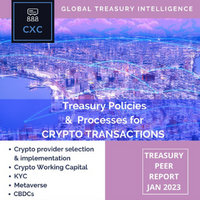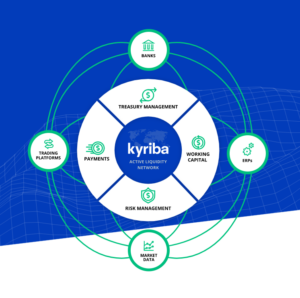 https://treasuryxl.com/wp-content/uploads/2025/09/Nomentia-BLOGS-featured-5.png
200
200
treasuryXL
https://treasuryxl.com/wp-content/uploads/2018/07/treasuryXL-logo-300x56.png
treasuryXL2025-09-29 07:00:332025-09-26 15:08:48Nomentia and Mitigram Form Nordic Partnership to Bridge Treasury and Trade Finance
https://treasuryxl.com/wp-content/uploads/2025/09/Nomentia-BLOGS-featured-5.png
200
200
treasuryXL
https://treasuryxl.com/wp-content/uploads/2018/07/treasuryXL-logo-300x56.png
treasuryXL2025-09-29 07:00:332025-09-26 15:08:48Nomentia and Mitigram Form Nordic Partnership to Bridge Treasury and Trade FinanceRegulations are an essential aspect of managing a treasury department. They help ensure that financial operations are conducted in a safe and compliant manner, protecting both the organization and its stakeholders. However, navigating the complex web of regulations can be a daunting task. In this article, we will explore the basics of treasury department regulations, where and how to find them, and how to ensure compliance.
What are Treasury Department regulations?
The first question to consider is what exactly are treasury department regulations? These regulations encompass a wide range of laws and guidelines that pertain to financial operations. They can include everything from accounting standards and financial reporting requirements to anti-money laundering laws and sanctions compliance. Treasury professionals need to stay informed and compliant with all relevant regulations to ensure the smooth and safe operation of financial activities.
Where to Find Treasury Regulations?
So where and how can you find treasury regulations? One of the best resources for treasury professionals is the website of the relevant regulatory body. For example, the Securities and Exchange Commission (SEC) and the Commodity Futures Trading Commission (CFTC) regulate securities and commodities trading, respectively. These organizations often publish guidelines and regulations on their websites, which can be accessed by the public. Additionally, you can also consult with legal and compliance experts to ensure that your organization complies with all relevant regulations.
Ensuring compliance with regulations is an ongoing process. It is important to have a robust compliance program in place that includes regular training for employees and regular self-assessments to identify and address any areas of non-compliance. It is also essential to have a designated compliance officer who is responsible for monitoring and enforcing compliance with regulations.
Instant Payment Regulations
The EU Parliament has adopted a regulation mandating instant payments for euro transfers within 10 seconds, with identity checks and no extra charges compared to standard transfers. This applies to all EU members, even those with non-euro currencies, after a transition period. The regulation also includes anti-fraud measures, customer protection rules, and harmonized sanctions screening for payment service providers. While beneficial for treasurers and boosting open banking, implementation will pose technical challenges for providers.
Conclusion
In conclusion, regulations play a crucial role in ensuring the safe and compliant operation of a treasury department. Staying informed and compliant with all relevant regulations is essential for protecting the organization
Click and Scroll! Here are more articles that you might like…
 https://treasuryxl.com/wp-content/uploads/2025/09/Nomentia-BLOGS-featured-5.png
200
200
treasuryXL
https://treasuryxl.com/wp-content/uploads/2018/07/treasuryXL-logo-300x56.png
treasuryXL2025-09-29 07:00:332025-09-26 15:08:48Nomentia and Mitigram Form Nordic Partnership to Bridge Treasury and Trade Finance
https://treasuryxl.com/wp-content/uploads/2025/09/Nomentia-BLOGS-featured-5.png
200
200
treasuryXL
https://treasuryxl.com/wp-content/uploads/2018/07/treasuryXL-logo-300x56.png
treasuryXL2025-09-29 07:00:332025-09-26 15:08:48Nomentia and Mitigram Form Nordic Partnership to Bridge Treasury and Trade Finance https://treasuryxl.com/wp-content/uploads/2025/01/Nomentia-BLOGS-featured-1.png
200
200
treasuryXL
https://treasuryxl.com/wp-content/uploads/2018/07/treasuryXL-logo-300x56.png
treasuryXL2025-09-17 07:55:082025-09-17 07:55:08How to turn your controlling plan into a reliable cash flow forecast
https://treasuryxl.com/wp-content/uploads/2025/01/Nomentia-BLOGS-featured-1.png
200
200
treasuryXL
https://treasuryxl.com/wp-content/uploads/2018/07/treasuryXL-logo-300x56.png
treasuryXL2025-09-17 07:55:082025-09-17 07:55:08How to turn your controlling plan into a reliable cash flow forecast https://treasuryxl.com/wp-content/uploads/2025/09/Nomentia-BLOGS-featured-4.png
200
200
treasuryXL
https://treasuryxl.com/wp-content/uploads/2018/07/treasuryXL-logo-300x56.png
treasuryXL2025-09-01 08:45:572025-09-01 08:47:32Millions of Payments, One Solution – OTTO Payments Chooses Nomentia
https://treasuryxl.com/wp-content/uploads/2025/09/Nomentia-BLOGS-featured-4.png
200
200
treasuryXL
https://treasuryxl.com/wp-content/uploads/2018/07/treasuryXL-logo-300x56.png
treasuryXL2025-09-01 08:45:572025-09-01 08:47:32Millions of Payments, One Solution – OTTO Payments Chooses Nomentia https://treasuryxl.com/wp-content/uploads/2025/01/Nomentia-BLOGS-featured-1.png
200
200
treasuryXL
https://treasuryxl.com/wp-content/uploads/2018/07/treasuryXL-logo-300x56.png
treasuryXL2025-08-18 07:00:552025-08-15 13:42:35How to build a business case for a payment hub?
https://treasuryxl.com/wp-content/uploads/2025/01/Nomentia-BLOGS-featured-1.png
200
200
treasuryXL
https://treasuryxl.com/wp-content/uploads/2018/07/treasuryXL-logo-300x56.png
treasuryXL2025-08-18 07:00:552025-08-15 13:42:35How to build a business case for a payment hub? https://treasuryxl.com/wp-content/uploads/2025/08/Nomentia-BLOGS-featured-3.png
200
200
treasuryXL
https://treasuryxl.com/wp-content/uploads/2018/07/treasuryXL-logo-300x56.png
treasuryXL2025-08-07 08:13:452025-08-07 08:14:33Real-time treasury: Beyond bank connections & controls
https://treasuryxl.com/wp-content/uploads/2025/08/Nomentia-BLOGS-featured-3.png
200
200
treasuryXL
https://treasuryxl.com/wp-content/uploads/2018/07/treasuryXL-logo-300x56.png
treasuryXL2025-08-07 08:13:452025-08-07 08:14:33Real-time treasury: Beyond bank connections & controls https://treasuryxl.com/wp-content/uploads/2025/06/Surecomp-BLOGS-featured-7.png
200
200
treasuryXL
https://treasuryxl.com/wp-content/uploads/2018/07/treasuryXL-logo-300x56.png
treasuryXL2025-06-30 07:00:312025-06-25 17:21:274 Key Takeaways On Trade Finance And Treasury
https://treasuryxl.com/wp-content/uploads/2025/06/Surecomp-BLOGS-featured-7.png
200
200
treasuryXL
https://treasuryxl.com/wp-content/uploads/2018/07/treasuryXL-logo-300x56.png
treasuryXL2025-06-30 07:00:312025-06-25 17:21:274 Key Takeaways On Trade Finance And Treasury https://treasuryxl.com/wp-content/uploads/2025/06/Surecomp-BLOGS-featured-6.png
200
200
treasuryXL
https://treasuryxl.com/wp-content/uploads/2018/07/treasuryXL-logo-300x56.png
treasuryXL2025-06-23 07:00:322025-06-19 10:16:24AI, Digital Adoption, and Real Transparency – Questions from Our Trade Finance Session
https://treasuryxl.com/wp-content/uploads/2025/06/Surecomp-BLOGS-featured-6.png
200
200
treasuryXL
https://treasuryxl.com/wp-content/uploads/2018/07/treasuryXL-logo-300x56.png
treasuryXL2025-06-23 07:00:322025-06-19 10:16:24AI, Digital Adoption, and Real Transparency – Questions from Our Trade Finance Session https://treasuryxl.com/wp-content/uploads/2025/06/Aviva-BLOGS-featured-6.png
200
200
treasuryXL
https://treasuryxl.com/wp-content/uploads/2018/07/treasuryXL-logo-300x56.png
treasuryXL2025-06-12 07:00:052025-06-26 08:44:44Money Market Funds: An overview for corporate treasurers and investors
https://treasuryxl.com/wp-content/uploads/2025/06/Aviva-BLOGS-featured-6.png
200
200
treasuryXL
https://treasuryxl.com/wp-content/uploads/2018/07/treasuryXL-logo-300x56.png
treasuryXL2025-06-12 07:00:052025-06-26 08:44:44Money Market Funds: An overview for corporate treasurers and investors https://treasuryxl.com/wp-content/uploads/2025/01/Nomentia-BLOGS-featured-1.png
200
200
treasuryXL
https://treasuryxl.com/wp-content/uploads/2018/07/treasuryXL-logo-300x56.png
treasuryXL2025-05-20 07:00:332025-05-19 14:03:02Sanctions screening compliance excuses, debunked
https://treasuryxl.com/wp-content/uploads/2025/01/Nomentia-BLOGS-featured-1.png
200
200
treasuryXL
https://treasuryxl.com/wp-content/uploads/2018/07/treasuryXL-logo-300x56.png
treasuryXL2025-05-20 07:00:332025-05-19 14:03:02Sanctions screening compliance excuses, debunked https://treasuryxl.com/wp-content/uploads/2024/08/Surecomp-BLOGS-featured-3.png
200
200
treasuryXL
https://treasuryxl.com/wp-content/uploads/2018/07/treasuryXL-logo-300x56.png
treasuryXL2025-05-08 07:00:302025-05-09 08:33:18Using Tech to Tackle Trade Tariff Turbulence
https://treasuryxl.com/wp-content/uploads/2024/08/Surecomp-BLOGS-featured-3.png
200
200
treasuryXL
https://treasuryxl.com/wp-content/uploads/2018/07/treasuryXL-logo-300x56.png
treasuryXL2025-05-08 07:00:302025-05-09 08:33:18Using Tech to Tackle Trade Tariff Turbulence https://treasuryxl.com/wp-content/uploads/2025/04/Embat-BLOGS-featured-6.png
200
200
treasuryXL
https://treasuryxl.com/wp-content/uploads/2018/07/treasuryXL-logo-300x56.png
treasuryXL2025-05-07 07:00:422025-08-26 17:44:11Cross-Border Payments and Treasury | From Bottlenecks to Efficiency
https://treasuryxl.com/wp-content/uploads/2025/04/Embat-BLOGS-featured-6.png
200
200
treasuryXL
https://treasuryxl.com/wp-content/uploads/2018/07/treasuryXL-logo-300x56.png
treasuryXL2025-05-07 07:00:422025-08-26 17:44:11Cross-Border Payments and Treasury | From Bottlenecks to Efficiency https://treasuryxl.com/wp-content/uploads/2024/08/Surecomp-BLOGS-featured-3.png
200
200
treasuryXL
https://treasuryxl.com/wp-content/uploads/2018/07/treasuryXL-logo-300x56.png
treasuryXL2025-04-23 07:00:432025-04-18 15:09:17Tech Compliance: What do Trade Finance banks need to know right now?
https://treasuryxl.com/wp-content/uploads/2024/08/Surecomp-BLOGS-featured-3.png
200
200
treasuryXL
https://treasuryxl.com/wp-content/uploads/2018/07/treasuryXL-logo-300x56.png
treasuryXL2025-04-23 07:00:432025-04-18 15:09:17Tech Compliance: What do Trade Finance banks need to know right now? https://treasuryxl.com/wp-content/uploads/2025/01/Nomentia-BLOGS-featured-1.png
200
200
treasuryXL
https://treasuryxl.com/wp-content/uploads/2018/07/treasuryXL-logo-300x56.png
treasuryXL2025-04-07 07:00:542025-04-03 11:16:22Cash pools and in-house bank – Everything you need to know
https://treasuryxl.com/wp-content/uploads/2025/01/Nomentia-BLOGS-featured-1.png
200
200
treasuryXL
https://treasuryxl.com/wp-content/uploads/2018/07/treasuryXL-logo-300x56.png
treasuryXL2025-04-07 07:00:542025-04-03 11:16:22Cash pools and in-house bank – Everything you need to know https://treasuryxl.com/wp-content/uploads/2025/01/Nomentia-BLOGS-featured-1.png
200
200
treasuryXL
https://treasuryxl.com/wp-content/uploads/2018/07/treasuryXL-logo-300x56.png
treasuryXL2025-03-26 07:00:562025-03-25 21:48:49Why Excel fails at cash flow forecasting?
https://treasuryxl.com/wp-content/uploads/2025/01/Nomentia-BLOGS-featured-1.png
200
200
treasuryXL
https://treasuryxl.com/wp-content/uploads/2018/07/treasuryXL-logo-300x56.png
treasuryXL2025-03-26 07:00:562025-03-25 21:48:49Why Excel fails at cash flow forecasting? https://treasuryxl.com/wp-content/uploads/2024/08/Surecomp-BLOGS-featured-3.png
200
200
treasuryXL
https://treasuryxl.com/wp-content/uploads/2018/07/treasuryXL-logo-300x56.png
treasuryXL2025-02-03 07:00:272025-01-31 15:53:55Leveraging Generative AI for Trade Finance Automation
https://treasuryxl.com/wp-content/uploads/2024/08/Surecomp-BLOGS-featured-3.png
200
200
treasuryXL
https://treasuryxl.com/wp-content/uploads/2018/07/treasuryXL-logo-300x56.png
treasuryXL2025-02-03 07:00:272025-01-31 15:53:55Leveraging Generative AI for Trade Finance Automation https://treasuryxl.com/wp-content/uploads/2024/10/Carlo-_BLOGS-Expert-featured-2.png
200
200
treasuryXL
https://treasuryxl.com/wp-content/uploads/2018/07/treasuryXL-logo-300x56.png
treasuryXL2025-01-30 07:00:172025-01-29 23:23:17Blockchain and Crypto Trends 2025: Further Integration with Traditional Finance
https://treasuryxl.com/wp-content/uploads/2024/10/Carlo-_BLOGS-Expert-featured-2.png
200
200
treasuryXL
https://treasuryxl.com/wp-content/uploads/2018/07/treasuryXL-logo-300x56.png
treasuryXL2025-01-30 07:00:172025-01-29 23:23:17Blockchain and Crypto Trends 2025: Further Integration with Traditional Finance https://treasuryxl.com/wp-content/uploads/2025/01/Francois-Template_BLOGS-Expert-featured-4.png
200
200
treasuryXL
https://treasuryxl.com/wp-content/uploads/2018/07/treasuryXL-logo-300x56.png
treasuryXL2025-01-23 07:00:062025-01-23 17:05:16Instant Payments Regulation and DORA entering into force
https://treasuryxl.com/wp-content/uploads/2025/01/Francois-Template_BLOGS-Expert-featured-4.png
200
200
treasuryXL
https://treasuryxl.com/wp-content/uploads/2018/07/treasuryXL-logo-300x56.png
treasuryXL2025-01-23 07:00:062025-01-23 17:05:16Instant Payments Regulation and DORA entering into force https://treasuryxl.com/wp-content/uploads/2025/01/Nomentia-BLOGS-featured-1.png
200
200
treasuryXL
https://treasuryxl.com/wp-content/uploads/2018/07/treasuryXL-logo-300x56.png
treasuryXL2025-01-15 07:00:332025-01-16 14:27:216 Treasury Management Trends for 2025
https://treasuryxl.com/wp-content/uploads/2025/01/Nomentia-BLOGS-featured-1.png
200
200
treasuryXL
https://treasuryxl.com/wp-content/uploads/2018/07/treasuryXL-logo-300x56.png
treasuryXL2025-01-15 07:00:332025-01-16 14:27:216 Treasury Management Trends for 2025 https://treasuryxl.com/wp-content/uploads/2024/08/Surecomp-BLOGS-featured-3.png
200
200
treasuryXL
https://treasuryxl.com/wp-content/uploads/2018/07/treasuryXL-logo-300x56.png
treasuryXL2025-01-14 07:00:582025-01-31 15:40:17The tide is turning on digital trade finance: Ride the wave or be swept out to sea?
https://treasuryxl.com/wp-content/uploads/2024/08/Surecomp-BLOGS-featured-3.png
200
200
treasuryXL
https://treasuryxl.com/wp-content/uploads/2018/07/treasuryXL-logo-300x56.png
treasuryXL2025-01-14 07:00:582025-01-31 15:40:17The tide is turning on digital trade finance: Ride the wave or be swept out to sea? https://treasuryxl.com/wp-content/uploads/2024/11/Surecomp-BLOGS-featured-4.png
200
200
treasuryXL
https://treasuryxl.com/wp-content/uploads/2018/07/treasuryXL-logo-300x56.png
treasuryXL2024-11-07 07:00:332024-11-04 12:52:38Leveraging Generative AI for Trade Finance Automation
https://treasuryxl.com/wp-content/uploads/2024/11/Surecomp-BLOGS-featured-4.png
200
200
treasuryXL
https://treasuryxl.com/wp-content/uploads/2018/07/treasuryXL-logo-300x56.png
treasuryXL2024-11-07 07:00:332024-11-04 12:52:38Leveraging Generative AI for Trade Finance Automation https://treasuryxl.com/wp-content/uploads/2024/08/Surecomp-BLOGS-featured-3.png
200
200
treasuryXL
https://treasuryxl.com/wp-content/uploads/2018/07/treasuryXL-logo-300x56.png
treasuryXL2024-10-28 07:00:122024-10-25 13:37:18Empowering Corporate Treasurers through Trade Finance Automation
https://treasuryxl.com/wp-content/uploads/2024/08/Surecomp-BLOGS-featured-3.png
200
200
treasuryXL
https://treasuryxl.com/wp-content/uploads/2018/07/treasuryXL-logo-300x56.png
treasuryXL2024-10-28 07:00:122024-10-25 13:37:18Empowering Corporate Treasurers through Trade Finance Automation https://treasuryxl.com/wp-content/uploads/2024/10/Carlo-_BLOGS-Expert-featured-2.png
200
200
treasuryXL
https://treasuryxl.com/wp-content/uploads/2018/07/treasuryXL-logo-300x56.png
treasuryXL2024-10-24 07:00:512024-10-24 08:20:58Traditional financial custodians enter the crypto market
https://treasuryxl.com/wp-content/uploads/2024/10/Carlo-_BLOGS-Expert-featured-2.png
200
200
treasuryXL
https://treasuryxl.com/wp-content/uploads/2018/07/treasuryXL-logo-300x56.png
treasuryXL2024-10-24 07:00:512024-10-24 08:20:58Traditional financial custodians enter the crypto market https://treasuryxl.com/wp-content/uploads/2024/01/Carlo-_BLOGS-Expert-featured.png
200
200
treasuryXL
https://treasuryxl.com/wp-content/uploads/2018/07/treasuryXL-logo-300x56.png
treasuryXL2024-10-09 07:00:042024-10-01 15:31:152024: a transformative and innovative year for DeFi
https://treasuryxl.com/wp-content/uploads/2024/01/Carlo-_BLOGS-Expert-featured.png
200
200
treasuryXL
https://treasuryxl.com/wp-content/uploads/2018/07/treasuryXL-logo-300x56.png
treasuryXL2024-10-09 07:00:042024-10-01 15:31:152024: a transformative and innovative year for DeFi https://treasuryxl.com/wp-content/uploads/2024/02/Carlo-_BLOGS-Expert-featured-1.png
200
200
treasuryXL
https://treasuryxl.com/wp-content/uploads/2018/07/treasuryXL-logo-300x56.png
treasuryXL2024-09-23 07:00:322024-09-23 09:33:13MiCA regulation for stablecoins: standard for worldwide application
https://treasuryxl.com/wp-content/uploads/2024/02/Carlo-_BLOGS-Expert-featured-1.png
200
200
treasuryXL
https://treasuryxl.com/wp-content/uploads/2018/07/treasuryXL-logo-300x56.png
treasuryXL2024-09-23 07:00:322024-09-23 09:33:13MiCA regulation for stablecoins: standard for worldwide application https://treasuryxl.com/wp-content/uploads/2024/07/Surecomp-BLOGS-featured-2.png
200
200
treasuryXL
https://treasuryxl.com/wp-content/uploads/2018/07/treasuryXL-logo-300x56.png
treasuryXL2024-09-05 11:35:002024-09-05 11:35:00Press Release | EP Resources Selects Surecomp’s RIVO™ to Automate Documentary Trade Credit
https://treasuryxl.com/wp-content/uploads/2024/07/Surecomp-BLOGS-featured-2.png
200
200
treasuryXL
https://treasuryxl.com/wp-content/uploads/2018/07/treasuryXL-logo-300x56.png
treasuryXL2024-09-05 11:35:002024-09-05 11:35:00Press Release | EP Resources Selects Surecomp’s RIVO™ to Automate Documentary Trade Credit https://treasuryxl.com/wp-content/uploads/2024/08/Surecomp-BLOGS-featured-3.png
200
200
treasuryXL
https://treasuryxl.com/wp-content/uploads/2018/07/treasuryXL-logo-300x56.png
treasuryXL2024-08-05 07:00:332025-01-07 11:09:47Why should businesses digitize their trade transactions?
https://treasuryxl.com/wp-content/uploads/2024/08/Surecomp-BLOGS-featured-3.png
200
200
treasuryXL
https://treasuryxl.com/wp-content/uploads/2018/07/treasuryXL-logo-300x56.png
treasuryXL2024-08-05 07:00:332025-01-07 11:09:47Why should businesses digitize their trade transactions? https://treasuryxl.com/wp-content/uploads/2024/07/Surecomp-BLOGS-featured-2.png
200
200
treasuryXL
https://treasuryxl.com/wp-content/uploads/2018/07/treasuryXL-logo-300x56.png
treasuryXL2024-07-30 11:40:142024-07-30 11:40:14Press Release | Surecomp and Visa collaborate to enhance trade finance and cross-border payments
https://treasuryxl.com/wp-content/uploads/2024/07/Surecomp-BLOGS-featured-2.png
200
200
treasuryXL
https://treasuryxl.com/wp-content/uploads/2018/07/treasuryXL-logo-300x56.png
treasuryXL2024-07-30 11:40:142024-07-30 11:40:14Press Release | Surecomp and Visa collaborate to enhance trade finance and cross-border payments https://treasuryxl.com/wp-content/uploads/2024/01/Carlo-_BLOGS-Expert-featured.png
200
200
treasuryXL
https://treasuryxl.com/wp-content/uploads/2018/07/treasuryXL-logo-300x56.png
treasuryXL2024-07-24 07:00:312024-07-24 09:05:06The Corporate Treasurer and Blockchain
https://treasuryxl.com/wp-content/uploads/2024/01/Carlo-_BLOGS-Expert-featured.png
200
200
treasuryXL
https://treasuryxl.com/wp-content/uploads/2018/07/treasuryXL-logo-300x56.png
treasuryXL2024-07-24 07:00:312024-07-24 09:05:06The Corporate Treasurer and Blockchain https://treasuryxl.com/wp-content/uploads/2024/06/Surecomp-BLOGS-featured-1.png
200
200
treasuryXL
https://treasuryxl.com/wp-content/uploads/2018/07/treasuryXL-logo-300x56.png
treasuryXL2024-06-25 07:00:462024-07-15 15:15:41From Paper to Digital in One Hour: How RIVO is Revolutionizing Trade Finance with Electronic Bills of Lading
https://treasuryxl.com/wp-content/uploads/2024/06/Surecomp-BLOGS-featured-1.png
200
200
treasuryXL
https://treasuryxl.com/wp-content/uploads/2018/07/treasuryXL-logo-300x56.png
treasuryXL2024-06-25 07:00:462024-07-15 15:15:41From Paper to Digital in One Hour: How RIVO is Revolutionizing Trade Finance with Electronic Bills of Lading https://treasuryxl.com/wp-content/uploads/2024/02/Carlo-_BLOGS-Expert-featured-1.png
200
200
treasuryXL
https://treasuryxl.com/wp-content/uploads/2018/07/treasuryXL-logo-300x56.png
treasuryXL2024-06-17 09:00:412024-06-17 09:03:52Ripple stablecoin launch: a game changer
https://treasuryxl.com/wp-content/uploads/2024/02/Carlo-_BLOGS-Expert-featured-1.png
200
200
treasuryXL
https://treasuryxl.com/wp-content/uploads/2018/07/treasuryXL-logo-300x56.png
treasuryXL2024-06-17 09:00:412024-06-17 09:03:52Ripple stablecoin launch: a game changer https://treasuryxl.com/wp-content/uploads/2024/05/James-Template_BLOGS-Expert-featured.png
200
200
treasuryXL
https://treasuryxl.com/wp-content/uploads/2018/07/treasuryXL-logo-300x56.png
treasuryXL2024-06-10 07:00:142024-06-10 14:06:04£3.7 Trillion Unleashed! Exploring UK Bond Market Reforms and their European Ripple Effect.
https://treasuryxl.com/wp-content/uploads/2024/05/James-Template_BLOGS-Expert-featured.png
200
200
treasuryXL
https://treasuryxl.com/wp-content/uploads/2018/07/treasuryXL-logo-300x56.png
treasuryXL2024-06-10 07:00:142024-06-10 14:06:04£3.7 Trillion Unleashed! Exploring UK Bond Market Reforms and their European Ripple Effect. https://treasuryxl.com/wp-content/uploads/2024/03/Maarten-BLOGS-Expert-featured.png
200
200
treasuryXL
https://treasuryxl.com/wp-content/uploads/2018/07/treasuryXL-logo-300x56.png
treasuryXL2024-05-27 07:00:532024-06-18 11:21:07In House Financing vs Bank Financing
https://treasuryxl.com/wp-content/uploads/2024/03/Maarten-BLOGS-Expert-featured.png
200
200
treasuryXL
https://treasuryxl.com/wp-content/uploads/2018/07/treasuryXL-logo-300x56.png
treasuryXL2024-05-27 07:00:532024-06-18 11:21:07In House Financing vs Bank Financing https://treasuryxl.com/wp-content/uploads/2024/01/Carlo-_BLOGS-Expert-featured.png
200
200
treasuryXL
https://treasuryxl.com/wp-content/uploads/2018/07/treasuryXL-logo-300x56.png
treasuryXL2024-05-08 07:00:102024-05-02 15:41:35Blockchain and TradFi: from disruption to transformation
https://treasuryxl.com/wp-content/uploads/2024/01/Carlo-_BLOGS-Expert-featured.png
200
200
treasuryXL
https://treasuryxl.com/wp-content/uploads/2018/07/treasuryXL-logo-300x56.png
treasuryXL2024-05-08 07:00:102024-05-02 15:41:35Blockchain and TradFi: from disruption to transformation https://treasuryxl.com/wp-content/uploads/2024/04/Kopie-van-Maarten-BLOGS-Expert-featured.png
200
200
treasuryXL
https://treasuryxl.com/wp-content/uploads/2018/07/treasuryXL-logo-300x56.png
treasuryXL2024-05-02 07:00:512024-06-18 11:22:14What does In-House Banking mean, and what are the Benefits for Treasury?
https://treasuryxl.com/wp-content/uploads/2024/04/Kopie-van-Maarten-BLOGS-Expert-featured.png
200
200
treasuryXL
https://treasuryxl.com/wp-content/uploads/2018/07/treasuryXL-logo-300x56.png
treasuryXL2024-05-02 07:00:512024-06-18 11:22:14What does In-House Banking mean, and what are the Benefits for Treasury? https://treasuryxl.com/wp-content/uploads/2024/02/Francois-Template_BLOGS-Expert-featured-1.png
200
200
treasuryXL
https://treasuryxl.com/wp-content/uploads/2018/07/treasuryXL-logo-300x56.png
treasuryXL2024-04-23 07:00:502024-04-17 08:29:08RTGS, Instant Payments and the impact on Open Banking
https://treasuryxl.com/wp-content/uploads/2024/02/Francois-Template_BLOGS-Expert-featured-1.png
200
200
treasuryXL
https://treasuryxl.com/wp-content/uploads/2018/07/treasuryXL-logo-300x56.png
treasuryXL2024-04-23 07:00:502024-04-17 08:29:08RTGS, Instant Payments and the impact on Open Banking https://treasuryxl.com/wp-content/uploads/2024/03/Surecomp-BLOGS-featured.png
200
200
treasuryXL
https://treasuryxl.com/wp-content/uploads/2018/07/treasuryXL-logo-300x56.png
treasuryXL2024-04-02 07:00:462024-03-27 07:30:49Understanding the intricacies of Supply Chain Finance
https://treasuryxl.com/wp-content/uploads/2024/03/Surecomp-BLOGS-featured.png
200
200
treasuryXL
https://treasuryxl.com/wp-content/uploads/2018/07/treasuryXL-logo-300x56.png
treasuryXL2024-04-02 07:00:462024-03-27 07:30:49Understanding the intricacies of Supply Chain Finance https://treasuryxl.com/wp-content/uploads/2024/03/Maarten-BLOGS-Expert-featured.png
200
200
treasuryXL
https://treasuryxl.com/wp-content/uploads/2018/07/treasuryXL-logo-300x56.png
treasuryXL2024-03-28 07:00:332024-03-26 08:05:47Legal Aspects In-House Bank
https://treasuryxl.com/wp-content/uploads/2024/03/Maarten-BLOGS-Expert-featured.png
200
200
treasuryXL
https://treasuryxl.com/wp-content/uploads/2018/07/treasuryXL-logo-300x56.png
treasuryXL2024-03-28 07:00:332024-03-26 08:05:47Legal Aspects In-House Bank https://treasuryxl.com/wp-content/uploads/2024/02/Nomentia-Template_BLOGS-featured.png
200
200
treasuryXL
https://treasuryxl.com/wp-content/uploads/2018/07/treasuryXL-logo-300x56.png
treasuryXL2024-02-20 07:00:102025-06-23 11:19:23Bank Guarantee: Rules and Regulations
https://treasuryxl.com/wp-content/uploads/2024/02/Nomentia-Template_BLOGS-featured.png
200
200
treasuryXL
https://treasuryxl.com/wp-content/uploads/2018/07/treasuryXL-logo-300x56.png
treasuryXL2024-02-20 07:00:102025-06-23 11:19:23Bank Guarantee: Rules and Regulations https://treasuryxl.com/wp-content/uploads/2024/02/Carlo-_BLOGS-Expert-featured-1.png
200
200
treasuryXL
https://treasuryxl.com/wp-content/uploads/2018/07/treasuryXL-logo-300x56.png
treasuryXL2024-02-15 07:00:162024-02-14 16:29:45EBA AML/CFT Guidelines to crypto asset service providers (CASPs)
https://treasuryxl.com/wp-content/uploads/2024/02/Carlo-_BLOGS-Expert-featured-1.png
200
200
treasuryXL
https://treasuryxl.com/wp-content/uploads/2018/07/treasuryXL-logo-300x56.png
treasuryXL2024-02-15 07:00:162024-02-14 16:29:45EBA AML/CFT Guidelines to crypto asset service providers (CASPs) https://treasuryxl.com/wp-content/uploads/2024/02/Francois-Template_BLOGS-Expert-featured-1.png
200
200
treasuryXL
https://treasuryxl.com/wp-content/uploads/2018/07/treasuryXL-logo-300x56.png
treasuryXL2024-02-09 09:27:482024-02-09 11:54:54Instant Payments Regulations Adopted by the EU parliament
https://treasuryxl.com/wp-content/uploads/2024/02/Francois-Template_BLOGS-Expert-featured-1.png
200
200
treasuryXL
https://treasuryxl.com/wp-content/uploads/2018/07/treasuryXL-logo-300x56.png
treasuryXL2024-02-09 09:27:482024-02-09 11:54:54Instant Payments Regulations Adopted by the EU parliament https://treasuryxl.com/wp-content/uploads/2024/01/FDW-van-Template_BLOGS-featured.png
200
200
treasuryXL
https://treasuryxl.com/wp-content/uploads/2018/07/treasuryXL-logo-300x56.png
treasuryXL2024-01-31 12:00:102024-01-31 12:03:23Become an expert in International Treasury Management and Corporate Finance!
https://treasuryxl.com/wp-content/uploads/2024/01/FDW-van-Template_BLOGS-featured.png
200
200
treasuryXL
https://treasuryxl.com/wp-content/uploads/2018/07/treasuryXL-logo-300x56.png
treasuryXL2024-01-31 12:00:102024-01-31 12:03:23Become an expert in International Treasury Management and Corporate Finance! https://treasuryxl.com/wp-content/uploads/2024/01/Francois-Template_BLOGS-Expert-featured.png
200
200
treasuryXL
https://treasuryxl.com/wp-content/uploads/2018/07/treasuryXL-logo-300x56.png
treasuryXL2024-01-25 07:00:042024-01-22 15:09:34Credit Ratings: Overview and Implications
https://treasuryxl.com/wp-content/uploads/2024/01/Francois-Template_BLOGS-Expert-featured.png
200
200
treasuryXL
https://treasuryxl.com/wp-content/uploads/2018/07/treasuryXL-logo-300x56.png
treasuryXL2024-01-25 07:00:042024-01-22 15:09:34Credit Ratings: Overview and Implications https://treasuryxl.com/wp-content/uploads/2024/01/Carlo-_BLOGS-Expert-featured.png
200
200
treasuryXL
https://treasuryxl.com/wp-content/uploads/2018/07/treasuryXL-logo-300x56.png
treasuryXL2024-01-22 07:00:062024-01-25 10:43:02Real world asset tokenization: breakthrough in 2024
https://treasuryxl.com/wp-content/uploads/2024/01/Carlo-_BLOGS-Expert-featured.png
200
200
treasuryXL
https://treasuryxl.com/wp-content/uploads/2018/07/treasuryXL-logo-300x56.png
treasuryXL2024-01-22 07:00:062024-01-25 10:43:02Real world asset tokenization: breakthrough in 2024 https://treasuryxl.com/wp-content/uploads/2023/09/Farncois-Template_BLOGS-Expert-featured-1.png
200
200
treasuryXL
https://treasuryxl.com/wp-content/uploads/2018/07/treasuryXL-logo-300x56.png
treasuryXL2024-01-15 07:00:522024-02-09 09:42:22Upcoming EU Regulations Impacting Corporate Payments
https://treasuryxl.com/wp-content/uploads/2023/09/Farncois-Template_BLOGS-Expert-featured-1.png
200
200
treasuryXL
https://treasuryxl.com/wp-content/uploads/2018/07/treasuryXL-logo-300x56.png
treasuryXL2024-01-15 07:00:522024-02-09 09:42:22Upcoming EU Regulations Impacting Corporate Payments https://treasuryxl.com/wp-content/uploads/2023/12/Blog-carlo-trends-200.png
200
200
treasuryXL
https://treasuryxl.com/wp-content/uploads/2018/07/treasuryXL-logo-300x56.png
treasuryXL2023-12-19 07:00:452024-02-14 11:45:14Main trends in blockchain and crypto in 2024: A great year
https://treasuryxl.com/wp-content/uploads/2023/12/Blog-carlo-trends-200.png
200
200
treasuryXL
https://treasuryxl.com/wp-content/uploads/2018/07/treasuryXL-logo-300x56.png
treasuryXL2023-12-19 07:00:452024-02-14 11:45:14Main trends in blockchain and crypto in 2024: A great year https://treasuryxl.com/wp-content/uploads/2023/12/FDW-Digital-Finance-Summit-200.png
200
200
treasuryXL
https://treasuryxl.com/wp-content/uploads/2018/07/treasuryXL-logo-300x56.png
treasuryXL2023-12-13 07:00:282023-12-14 09:08:40Update Digital Finance Summit 2023
https://treasuryxl.com/wp-content/uploads/2023/12/FDW-Digital-Finance-Summit-200.png
200
200
treasuryXL
https://treasuryxl.com/wp-content/uploads/2018/07/treasuryXL-logo-300x56.png
treasuryXL2023-12-13 07:00:282023-12-14 09:08:40Update Digital Finance Summit 2023 https://treasuryxl.com/wp-content/uploads/2023/11/QA-LIBOR.png
200
200
treasuryXL
https://treasuryxl.com/wp-content/uploads/2018/07/treasuryXL-logo-300x56.png
treasuryXL2023-11-30 07:00:132023-11-30 09:07:38Q&A | LIBOR: The End Of An Era
https://treasuryxl.com/wp-content/uploads/2023/11/QA-LIBOR.png
200
200
treasuryXL
https://treasuryxl.com/wp-content/uploads/2018/07/treasuryXL-logo-300x56.png
treasuryXL2023-11-30 07:00:132023-11-30 09:07:38Q&A | LIBOR: The End Of An Era https://treasuryxl.com/wp-content/uploads/2023/11/Blog-surecomp-200-1.png
200
200
treasuryXL
https://treasuryxl.com/wp-content/uploads/2018/07/treasuryXL-logo-300x56.png
treasuryXL2023-11-23 07:00:222023-11-14 16:48:45Top trade finance trends to watch in 2024
https://treasuryxl.com/wp-content/uploads/2023/11/Blog-surecomp-200-1.png
200
200
treasuryXL
https://treasuryxl.com/wp-content/uploads/2018/07/treasuryXL-logo-300x56.png
treasuryXL2023-11-23 07:00:222023-11-14 16:48:45Top trade finance trends to watch in 2024 https://treasuryxl.com/wp-content/uploads/2023/10/Carlo-200-16e.png
200
200
treasuryXL
https://treasuryxl.com/wp-content/uploads/2018/07/treasuryXL-logo-300x56.png
treasuryXL2023-11-16 07:00:362023-11-06 14:12:16Blockchain interoperability solutions and challenges: Where are we now?
https://treasuryxl.com/wp-content/uploads/2023/10/Carlo-200-16e.png
200
200
treasuryXL
https://treasuryxl.com/wp-content/uploads/2018/07/treasuryXL-logo-300x56.png
treasuryXL2023-11-16 07:00:362023-11-06 14:12:16Blockchain interoperability solutions and challenges: Where are we now? https://treasuryxl.com/wp-content/uploads/2023/10/Carlo-200-17e.png
200
200
treasuryXL
https://treasuryxl.com/wp-content/uploads/2018/07/treasuryXL-logo-300x56.png
treasuryXL2023-10-17 07:00:432023-10-13 12:41:21Blockchain and the scalability challenge: solving the blockchain trilemma
https://treasuryxl.com/wp-content/uploads/2023/10/Carlo-200-17e.png
200
200
treasuryXL
https://treasuryxl.com/wp-content/uploads/2018/07/treasuryXL-logo-300x56.png
treasuryXL2023-10-17 07:00:432023-10-13 12:41:21Blockchain and the scalability challenge: solving the blockchain trilemma https://treasuryxl.com/wp-content/uploads/2023/09/Carlo-200-26e.png
200
200
treasuryXL
https://treasuryxl.com/wp-content/uploads/2018/07/treasuryXL-logo-300x56.png
treasuryXL2023-09-26 07:00:312023-09-21 16:41:41BlackRock spot Bitcoin ETF application: a rocky way towards approval
https://treasuryxl.com/wp-content/uploads/2023/09/Carlo-200-26e.png
200
200
treasuryXL
https://treasuryxl.com/wp-content/uploads/2018/07/treasuryXL-logo-300x56.png
treasuryXL2023-09-26 07:00:312023-09-21 16:41:41BlackRock spot Bitcoin ETF application: a rocky way towards approval https://treasuryxl.com/wp-content/uploads/2023/08/carlo-web3.0-200.png
200
200
treasuryXL
https://treasuryxl.com/wp-content/uploads/2018/07/treasuryXL-logo-300x56.png
treasuryXL2023-08-28 07:00:412023-08-24 13:49:33Blockchain and Web3.0: A great Marriage
https://treasuryxl.com/wp-content/uploads/2023/08/carlo-web3.0-200.png
200
200
treasuryXL
https://treasuryxl.com/wp-content/uploads/2018/07/treasuryXL-logo-300x56.png
treasuryXL2023-08-28 07:00:412023-08-24 13:49:33Blockchain and Web3.0: A great Marriage https://treasuryxl.com/wp-content/uploads/2023/07/blog-carlo-200-1.png
200
200
treasuryXL
https://treasuryxl.com/wp-content/uploads/2018/07/treasuryXL-logo-300x56.png
treasuryXL2023-07-31 07:00:302023-07-25 16:26:14Swift blockchain interoperability experimentation
https://treasuryxl.com/wp-content/uploads/2023/07/blog-carlo-200-1.png
200
200
treasuryXL
https://treasuryxl.com/wp-content/uploads/2018/07/treasuryXL-logo-300x56.png
treasuryXL2023-07-31 07:00:302023-07-25 16:26:14Swift blockchain interoperability experimentation https://treasuryxl.com/wp-content/uploads/2023/07/Anastasia-blog-2-200.png
200
200
treasuryXL
https://treasuryxl.com/wp-content/uploads/2018/07/treasuryXL-logo-300x56.png
treasuryXL2023-07-24 07:00:102023-07-24 09:06:35Sustainable Finance | What , Why, and the Difference with ESG
https://treasuryxl.com/wp-content/uploads/2023/07/Anastasia-blog-2-200.png
200
200
treasuryXL
https://treasuryxl.com/wp-content/uploads/2018/07/treasuryXL-logo-300x56.png
treasuryXL2023-07-24 07:00:102023-07-24 09:06:35Sustainable Finance | What , Why, and the Difference with ESG https://treasuryxl.com/wp-content/uploads/2023/06/STFI-200.png
200
200
treasuryXL
https://treasuryxl.com/wp-content/uploads/2018/07/treasuryXL-logo-300x56.png
treasuryXL2023-07-19 07:00:552023-06-27 14:36:492nd Annual Stress Testing for Financial Institutions
https://treasuryxl.com/wp-content/uploads/2023/06/STFI-200.png
200
200
treasuryXL
https://treasuryxl.com/wp-content/uploads/2018/07/treasuryXL-logo-300x56.png
treasuryXL2023-07-19 07:00:552023-06-27 14:36:492nd Annual Stress Testing for Financial Institutions https://treasuryxl.com/wp-content/uploads/2023/06/CRMMAV-200.png
200
200
treasuryXL
https://treasuryxl.com/wp-content/uploads/2018/07/treasuryXL-logo-300x56.png
treasuryXL2023-07-04 10:00:242023-06-27 14:38:0110th Annual Credit Risk Management, Modelling and Validation
https://treasuryxl.com/wp-content/uploads/2023/06/CRMMAV-200.png
200
200
treasuryXL
https://treasuryxl.com/wp-content/uploads/2018/07/treasuryXL-logo-300x56.png
treasuryXL2023-07-04 10:00:242023-06-27 14:38:0110th Annual Credit Risk Management, Modelling and Validation https://treasuryxl.com/wp-content/uploads/2023/06/Kopie-van-anastasia-200.png
200
200
treasuryXL
https://treasuryxl.com/wp-content/uploads/2018/07/treasuryXL-logo-300x56.png
treasuryXL2023-06-29 07:00:052023-10-03 16:22:28What is ESG? A Corporate Perspective
https://treasuryxl.com/wp-content/uploads/2023/06/Kopie-van-anastasia-200.png
200
200
treasuryXL
https://treasuryxl.com/wp-content/uploads/2018/07/treasuryXL-logo-300x56.png
treasuryXL2023-06-29 07:00:052023-10-03 16:22:28What is ESG? A Corporate Perspective https://treasuryxl.com/wp-content/uploads/2023/06/cmu341-200-×-200-px.jpg
200
200
treasuryXL
https://treasuryxl.com/wp-content/uploads/2018/07/treasuryXL-logo-300x56.png
treasuryXL2023-06-26 07:00:532023-06-26 11:55:23GFMI Announces the 10th Annual Liquidity and Funding Risk Management Conference in New York
https://treasuryxl.com/wp-content/uploads/2023/06/cmu341-200-×-200-px.jpg
200
200
treasuryXL
https://treasuryxl.com/wp-content/uploads/2018/07/treasuryXL-logo-300x56.png
treasuryXL2023-06-26 07:00:532023-06-26 11:55:23GFMI Announces the 10th Annual Liquidity and Funding Risk Management Conference in New York https://treasuryxl.com/wp-content/uploads/2023/06/Digital-euro-200.png
200
200
treasuryXL
https://treasuryxl.com/wp-content/uploads/2018/07/treasuryXL-logo-300x56.png
treasuryXL2023-06-13 07:00:022023-06-12 10:06:42The digital euro project: we are not there yet!
https://treasuryxl.com/wp-content/uploads/2023/06/Digital-euro-200.png
200
200
treasuryXL
https://treasuryxl.com/wp-content/uploads/2018/07/treasuryXL-logo-300x56.png
treasuryXL2023-06-13 07:00:022023-06-12 10:06:42The digital euro project: we are not there yet! https://treasuryxl.com/wp-content/uploads/2023/06/cxc-200-13e.png
200
200
treasuryXL
https://treasuryxl.com/wp-content/uploads/2018/07/treasuryXL-logo-300x56.png
treasuryXL2023-06-12 07:00:052024-11-04 15:28:14AI & Robotics in Corporate Treasury
https://treasuryxl.com/wp-content/uploads/2023/06/cxc-200-13e.png
200
200
treasuryXL
https://treasuryxl.com/wp-content/uploads/2018/07/treasuryXL-logo-300x56.png
treasuryXL2023-06-12 07:00:052024-11-04 15:28:14AI & Robotics in Corporate Treasury https://treasuryxl.com/wp-content/uploads/2023/05/cxc-200-23e.png
200
200
treasuryXL
https://treasuryxl.com/wp-content/uploads/2018/07/treasuryXL-logo-300x56.png
treasuryXL2023-05-23 07:00:292023-05-23 08:41:38Approaches to Investing Trapped Cash
https://treasuryxl.com/wp-content/uploads/2023/05/cxc-200-23e.png
200
200
treasuryXL
https://treasuryxl.com/wp-content/uploads/2018/07/treasuryXL-logo-300x56.png
treasuryXL2023-05-23 07:00:292023-05-23 08:41:38Approaches to Investing Trapped Cash https://treasuryxl.com/wp-content/uploads/2023/05/blog-carlo-200-15e.png
200
200
treasuryXL
https://treasuryxl.com/wp-content/uploads/2018/07/treasuryXL-logo-300x56.png
treasuryXL2023-05-15 07:00:452023-05-12 13:40:43The EU Regulatory Sandbox for Blockchain: a win-win situation
https://treasuryxl.com/wp-content/uploads/2023/05/blog-carlo-200-15e.png
200
200
treasuryXL
https://treasuryxl.com/wp-content/uploads/2018/07/treasuryXL-logo-300x56.png
treasuryXL2023-05-15 07:00:452023-05-12 13:40:43The EU Regulatory Sandbox for Blockchain: a win-win situation https://treasuryxl.com/wp-content/uploads/2023/05/cxc-200-10e.png
200
200
treasuryXL
https://treasuryxl.com/wp-content/uploads/2018/07/treasuryXL-logo-300x56.png
treasuryXL2023-05-10 07:00:172023-05-09 17:25:10FX & Currency Hedging Policy Review
https://treasuryxl.com/wp-content/uploads/2023/05/cxc-200-10e.png
200
200
treasuryXL
https://treasuryxl.com/wp-content/uploads/2018/07/treasuryXL-logo-300x56.png
treasuryXL2023-05-10 07:00:172023-05-09 17:25:10FX & Currency Hedging Policy Review https://treasuryxl.com/wp-content/uploads/2023/04/cxc-200-maandag.png
200
200
treasuryXL
https://treasuryxl.com/wp-content/uploads/2018/07/treasuryXL-logo-300x56.png
treasuryXL2023-04-17 07:00:032023-04-17 14:54:28Transacting with Sanctioned Countries
https://treasuryxl.com/wp-content/uploads/2023/04/cxc-200-maandag.png
200
200
treasuryXL
https://treasuryxl.com/wp-content/uploads/2018/07/treasuryXL-logo-300x56.png
treasuryXL2023-04-17 07:00:032023-04-17 14:54:28Transacting with Sanctioned Countries https://treasuryxl.com/wp-content/uploads/2023/02/unlock-200x200-1.png
200
200
treasuryXL
https://treasuryxl.com/wp-content/uploads/2018/07/treasuryXL-logo-300x56.png
treasuryXL2023-02-14 07:00:082023-04-06 09:55:32LIVE SESSION | Unlock the Benefits of Interim Treasury Management
https://treasuryxl.com/wp-content/uploads/2023/02/unlock-200x200-1.png
200
200
treasuryXL
https://treasuryxl.com/wp-content/uploads/2018/07/treasuryXL-logo-300x56.png
treasuryXL2023-02-14 07:00:082023-04-06 09:55:32LIVE SESSION | Unlock the Benefits of Interim Treasury Management https://treasuryxl.com/wp-content/uploads/2023/02/eurofinance-200.png
200
200
treasuryXL
https://treasuryxl.com/wp-content/uploads/2018/07/treasuryXL-logo-300x56.png
treasuryXL2023-02-07 07:00:202023-02-06 10:33:56Effective Finance & Treasury in Africa | Eurofinance
https://treasuryxl.com/wp-content/uploads/2023/02/eurofinance-200.png
200
200
treasuryXL
https://treasuryxl.com/wp-content/uploads/2018/07/treasuryXL-logo-300x56.png
treasuryXL2023-02-07 07:00:202023-02-06 10:33:56Effective Finance & Treasury in Africa | Eurofinance https://treasuryxl.com/wp-content/uploads/2023/02/Kopie-van-cxc-200.png
200
200
treasuryXL
https://treasuryxl.com/wp-content/uploads/2018/07/treasuryXL-logo-300x56.png
treasuryXL2023-02-02 07:00:122023-02-01 12:24:50Treasury Policies & Processes for Crypto Transactions
https://treasuryxl.com/wp-content/uploads/2023/02/Kopie-van-cxc-200.png
200
200
treasuryXL
https://treasuryxl.com/wp-content/uploads/2018/07/treasuryXL-logo-300x56.png
treasuryXL2023-02-02 07:00:122023-02-01 12:24:50Treasury Policies & Processes for Crypto Transactions https://treasuryxl.com/wp-content/uploads/2022/10/Pieter-Vienna.png
200
200
treasuryXL
https://treasuryxl.com/wp-content/uploads/2018/07/treasuryXL-logo-300x56.png
treasuryXL2022-10-12 14:42:432023-01-02 14:17:36Eurofinance remains THE event for corporate treasurers | By Pieter de Kiewit
https://treasuryxl.com/wp-content/uploads/2022/10/Pieter-Vienna.png
200
200
treasuryXL
https://treasuryxl.com/wp-content/uploads/2018/07/treasuryXL-logo-300x56.png
treasuryXL2022-10-12 14:42:432023-01-02 14:17:36Eurofinance remains THE event for corporate treasurers | By Pieter de Kiewit https://treasuryxl.com/wp-content/uploads/2022/09/WEBINAR.png
200
200
treasuryXL
https://treasuryxl.com/wp-content/uploads/2018/07/treasuryXL-logo-300x56.png
treasuryXL2022-09-29 07:00:452023-01-02 14:17:59LIVE SESSION | My Treasury Career Development & How the Register Treasurer education contributed
https://treasuryxl.com/wp-content/uploads/2022/09/WEBINAR.png
200
200
treasuryXL
https://treasuryxl.com/wp-content/uploads/2018/07/treasuryXL-logo-300x56.png
treasuryXL2022-09-29 07:00:452023-01-02 14:17:59LIVE SESSION | My Treasury Career Development & How the Register Treasurer education contributed https://treasuryxl.com/wp-content/uploads/2022/09/blog-pieter-19e-200.png
200
200
treasuryXL
https://treasuryxl.com/wp-content/uploads/2018/07/treasuryXL-logo-300x56.png
treasuryXL2022-09-19 07:00:032023-01-02 14:18:20Where did the treasury applicants go? | By Pieter de Kiewit
https://treasuryxl.com/wp-content/uploads/2022/09/blog-pieter-19e-200.png
200
200
treasuryXL
https://treasuryxl.com/wp-content/uploads/2018/07/treasuryXL-logo-300x56.png
treasuryXL2022-09-19 07:00:032023-01-02 14:18:20Where did the treasury applicants go? | By Pieter de Kiewit https://treasuryxl.com/wp-content/uploads/2022/09/Cash-and-Treasurer-featured-200x200-1.png
200
200
treasuryXL
https://treasuryxl.com/wp-content/uploads/2018/07/treasuryXL-logo-300x56.png
treasuryXL2022-09-06 11:00:102022-09-06 12:46:51RECAP | Cash and Treasury Management Event Copenhagen | By Pieter de Kiewit
https://treasuryxl.com/wp-content/uploads/2022/09/Cash-and-Treasurer-featured-200x200-1.png
200
200
treasuryXL
https://treasuryxl.com/wp-content/uploads/2018/07/treasuryXL-logo-300x56.png
treasuryXL2022-09-06 11:00:102022-09-06 12:46:51RECAP | Cash and Treasury Management Event Copenhagen | By Pieter de Kiewit https://treasuryxl.com/wp-content/uploads/2022/08/22cash-featured-200x200px4.jpg
200
200
treasuryXL
https://treasuryxl.com/wp-content/uploads/2018/07/treasuryXL-logo-300x56.png
treasuryXL2022-08-04 09:21:162022-08-04 09:21:16Cash & Treasury Management: Join The World’s Leading Experts in Copenhagen
https://treasuryxl.com/wp-content/uploads/2022/08/22cash-featured-200x200px4.jpg
200
200
treasuryXL
https://treasuryxl.com/wp-content/uploads/2018/07/treasuryXL-logo-300x56.png
treasuryXL2022-08-04 09:21:162022-08-04 09:21:16Cash & Treasury Management: Join The World’s Leading Experts in Copenhagen https://treasuryxl.com/wp-content/uploads/2022/06/treasuryXL-200x200-1.jpg
200
200
treasuryXL
https://treasuryxl.com/wp-content/uploads/2018/07/treasuryXL-logo-300x56.png
treasuryXL2022-06-13 07:00:552022-06-10 11:50:23Treasury in transition – explore the agenda for EuroFinance International Treasury Management
https://treasuryxl.com/wp-content/uploads/2022/06/treasuryXL-200x200-1.jpg
200
200
treasuryXL
https://treasuryxl.com/wp-content/uploads/2018/07/treasuryXL-logo-300x56.png
treasuryXL2022-06-13 07:00:552022-06-10 11:50:23Treasury in transition – explore the agenda for EuroFinance International Treasury Management
The world’s largest treasury event is returning to Vienna in September | 10% discount via treasuryXL
 https://treasuryxl.com/wp-content/uploads/2021/07/EuroFinance-pp.png
200
200
treasuryXL
https://treasuryxl.com/wp-content/uploads/2018/07/treasuryXL-logo-300x56.png
treasuryXL2022-04-08 12:16:452022-04-11 17:11:22EuroFinance International Treasury Management returns to Vienna | 21-23 September 2022
https://treasuryxl.com/wp-content/uploads/2021/07/EuroFinance-pp.png
200
200
treasuryXL
https://treasuryxl.com/wp-content/uploads/2018/07/treasuryXL-logo-300x56.png
treasuryXL2022-04-08 12:16:452022-04-11 17:11:22EuroFinance International Treasury Management returns to Vienna | 21-23 September 2022 https://treasuryxl.com/wp-content/uploads/2022/02/Website-200x200-1.jpg
200
200
treasuryXL
https://treasuryxl.com/wp-content/uploads/2018/07/treasuryXL-logo-300x56.png
treasuryXL2022-02-23 09:45:452022-02-22 16:16:43Effective Finance & Treasury in Africa event run by EuroFinance | London
https://treasuryxl.com/wp-content/uploads/2022/02/Website-200x200-1.jpg
200
200
treasuryXL
https://treasuryxl.com/wp-content/uploads/2018/07/treasuryXL-logo-300x56.png
treasuryXL2022-02-23 09:45:452022-02-22 16:16:43Effective Finance & Treasury in Africa event run by EuroFinance | London https://treasuryxl.com/wp-content/uploads/2017/02/Stopwatch.jpg
200
200
treasuryXL
https://treasuryxl.com/wp-content/uploads/2018/07/treasuryXL-logo-300x56.png
treasuryXL2022-02-20 07:30:032023-05-16 15:46:18Instant Payments: the SEPA Instant Payments rulebook is published, what’s next?
https://treasuryxl.com/wp-content/uploads/2017/02/Stopwatch.jpg
200
200
treasuryXL
https://treasuryxl.com/wp-content/uploads/2018/07/treasuryXL-logo-300x56.png
treasuryXL2022-02-20 07:30:032023-05-16 15:46:18Instant Payments: the SEPA Instant Payments rulebook is published, what’s next? https://treasuryxl.com/wp-content/uploads/2024/01/Francois-Template_BLOGS-Expert-featured.png
200
200
treasuryXL
https://treasuryxl.com/wp-content/uploads/2018/07/treasuryXL-logo-300x56.png
treasuryXL2022-01-25 10:12:032024-01-25 10:14:22Credit Ratings: Overview and Implications
https://treasuryxl.com/wp-content/uploads/2024/01/Francois-Template_BLOGS-Expert-featured.png
200
200
treasuryXL
https://treasuryxl.com/wp-content/uploads/2018/07/treasuryXL-logo-300x56.png
treasuryXL2022-01-25 10:12:032024-01-25 10:14:22Credit Ratings: Overview and Implications https://treasuryxl.com/wp-content/uploads/2021/11/eurofinance-200.png
200
200
treasuryXL
https://treasuryxl.com/wp-content/uploads/2018/07/treasuryXL-logo-300x56.png
treasuryXL2021-11-15 07:00:252021-11-15 08:53:28Changing priorities of corporate treasurers post-pandemic
https://treasuryxl.com/wp-content/uploads/2021/11/eurofinance-200.png
200
200
treasuryXL
https://treasuryxl.com/wp-content/uploads/2018/07/treasuryXL-logo-300x56.png
treasuryXL2021-11-15 07:00:252021-11-15 08:53:28Changing priorities of corporate treasurers post-pandemic https://treasuryxl.com/wp-content/uploads/2021/05/EuroFinance-2021_.jpg
200
200
treasuryXL
https://treasuryxl.com/wp-content/uploads/2018/07/treasuryXL-logo-300x56.png
treasuryXL2021-09-22 07:00:222021-08-11 15:04:41Your Last Call | International Treasury Management Virtual Week | September 27 – October 1
https://treasuryxl.com/wp-content/uploads/2021/05/EuroFinance-2021_.jpg
200
200
treasuryXL
https://treasuryxl.com/wp-content/uploads/2018/07/treasuryXL-logo-300x56.png
treasuryXL2021-09-22 07:00:222021-08-11 15:04:41Your Last Call | International Treasury Management Virtual Week | September 27 – October 1 https://treasuryxl.com/wp-content/uploads/2021/07/Pearls.png
200
200
treasuryXL
https://treasuryxl.com/wp-content/uploads/2018/07/treasuryXL-logo-300x56.png
treasuryXL2021-08-03 07:00:482022-12-29 14:08:22Cloudiness in Libor Transition?
https://treasuryxl.com/wp-content/uploads/2021/07/Pearls.png
200
200
treasuryXL
https://treasuryxl.com/wp-content/uploads/2018/07/treasuryXL-logo-300x56.png
treasuryXL2021-08-03 07:00:482022-12-29 14:08:22Cloudiness in Libor Transition? https://treasuryxl.com/wp-content/uploads/2021/07/Kantox-Press-Release.png
200
200
treasuryXL
https://treasuryxl.com/wp-content/uploads/2018/07/treasuryXL-logo-300x56.png
treasuryXL2021-07-28 07:00:012022-12-29 14:36:44Press release | Kantox joins the treasuryXL community as Premium Partner
https://treasuryxl.com/wp-content/uploads/2021/07/Kantox-Press-Release.png
200
200
treasuryXL
https://treasuryxl.com/wp-content/uploads/2018/07/treasuryXL-logo-300x56.png
treasuryXL2021-07-28 07:00:012022-12-29 14:36:44Press release | Kantox joins the treasuryXL community as Premium Partner https://treasuryxl.com/wp-content/uploads/2021/07/abde.png
433
750
treasuryXL
https://treasuryxl.com/wp-content/uploads/2018/07/treasuryXL-logo-300x56.png
treasuryXL2021-07-14 07:00:272022-12-29 13:07:09E-Book: ERP Migration | How to Simplify and Accelerate Bank Integration
https://treasuryxl.com/wp-content/uploads/2021/07/abde.png
433
750
treasuryXL
https://treasuryxl.com/wp-content/uploads/2018/07/treasuryXL-logo-300x56.png
treasuryXL2021-07-14 07:00:272022-12-29 13:07:09E-Book: ERP Migration | How to Simplify and Accelerate Bank Integration https://treasuryxl.com/wp-content/uploads/2021/06/sorry.png
557
946
treasuryXL
https://treasuryxl.com/wp-content/uploads/2018/07/treasuryXL-logo-300x56.png
treasuryXL2021-06-28 07:00:292022-12-29 13:18:21How a Treasurer can really add Value
https://treasuryxl.com/wp-content/uploads/2021/06/sorry.png
557
946
treasuryXL
https://treasuryxl.com/wp-content/uploads/2018/07/treasuryXL-logo-300x56.png
treasuryXL2021-06-28 07:00:292022-12-29 13:18:21How a Treasurer can really add Value https://treasuryxl.com/wp-content/uploads/2021/06/Bitcoinnn.png
552
941
treasuryXL
https://treasuryxl.com/wp-content/uploads/2018/07/treasuryXL-logo-300x56.png
treasuryXL2021-06-15 07:00:182022-12-29 13:23:22Digital Currencies | Not Ready for Corporate Treasury
https://treasuryxl.com/wp-content/uploads/2021/06/Bitcoinnn.png
552
941
treasuryXL
https://treasuryxl.com/wp-content/uploads/2018/07/treasuryXL-logo-300x56.png
treasuryXL2021-06-15 07:00:182022-12-29 13:23:22Digital Currencies | Not Ready for Corporate Treasury https://treasuryxl.com/wp-content/uploads/2021/05/raakt.png
504
949
treasuryXL
https://treasuryxl.com/wp-content/uploads/2018/07/treasuryXL-logo-300x56.png
treasuryXL2021-06-01 07:00:122022-12-29 13:23:43Why CFOs Should Foster Stronger Relationships with Banks
https://treasuryxl.com/wp-content/uploads/2021/05/raakt.png
504
949
treasuryXL
https://treasuryxl.com/wp-content/uploads/2018/07/treasuryXL-logo-300x56.png
treasuryXL2021-06-01 07:00:122022-12-29 13:23:43Why CFOs Should Foster Stronger Relationships with Banks https://treasuryxl.com/wp-content/uploads/2021/05/searching.png
200
200
treasuryXL
https://treasuryxl.com/wp-content/uploads/2018/07/treasuryXL-logo-300x56.png
treasuryXL2021-05-19 07:00:062021-05-17 09:57:28International Treasury Management Virtual Week | Celebrating 30 years as the world’s leading treasury event
https://treasuryxl.com/wp-content/uploads/2021/05/searching.png
200
200
treasuryXL
https://treasuryxl.com/wp-content/uploads/2018/07/treasuryXL-logo-300x56.png
treasuryXL2021-05-19 07:00:062021-05-17 09:57:28International Treasury Management Virtual Week | Celebrating 30 years as the world’s leading treasury event https://treasuryxl.com/wp-content/uploads/2021/05/Global-Treasury-.png
200
200
treasuryXL
https://treasuryxl.com/wp-content/uploads/2018/07/treasuryXL-logo-300x56.png
treasuryXL2021-05-12 07:00:062021-05-10 10:52:05Global Treasury Americas | Planning the post-pandemic Treasury
https://treasuryxl.com/wp-content/uploads/2021/05/Global-Treasury-.png
200
200
treasuryXL
https://treasuryxl.com/wp-content/uploads/2018/07/treasuryXL-logo-300x56.png
treasuryXL2021-05-12 07:00:062021-05-10 10:52:05Global Treasury Americas | Planning the post-pandemic Treasury https://treasuryxl.com/wp-content/uploads/2021/05/AB.png
200
200
treasuryXL
https://treasuryxl.com/wp-content/uploads/2018/07/treasuryXL-logo-300x56.png
treasuryXL2021-05-10 07:00:532023-02-07 10:03:25Liquidity Benefits From Dynamic Discounting in Supply Chain Financing
https://treasuryxl.com/wp-content/uploads/2021/05/AB.png
200
200
treasuryXL
https://treasuryxl.com/wp-content/uploads/2018/07/treasuryXL-logo-300x56.png
treasuryXL2021-05-10 07:00:532023-02-07 10:03:25Liquidity Benefits From Dynamic Discounting in Supply Chain Financing https://treasuryxl.com/wp-content/uploads/2021/04/asdfgh.png
200
200
treasuryXL
https://treasuryxl.com/wp-content/uploads/2018/07/treasuryXL-logo-300x56.png
treasuryXL2021-04-20 07:00:592022-12-29 13:03:51How to Prepare for a New Era of Real-time Banking and Payment Services
https://treasuryxl.com/wp-content/uploads/2021/04/asdfgh.png
200
200
treasuryXL
https://treasuryxl.com/wp-content/uploads/2018/07/treasuryXL-logo-300x56.png
treasuryXL2021-04-20 07:00:592022-12-29 13:03:51How to Prepare for a New Era of Real-time Banking and Payment Services https://treasuryxl.com/wp-content/uploads/2021/03/Knipsel.png
542
937
treasuryXL
https://treasuryxl.com/wp-content/uploads/2018/07/treasuryXL-logo-300x56.png
treasuryXL2021-03-30 07:00:282022-12-29 13:19:42Centralising Payments and Fraud Management with Kyriba – Şişecam
https://treasuryxl.com/wp-content/uploads/2021/03/Knipsel.png
542
937
treasuryXL
https://treasuryxl.com/wp-content/uploads/2018/07/treasuryXL-logo-300x56.png
treasuryXL2021-03-30 07:00:282022-12-29 13:19:42Centralising Payments and Fraud Management with Kyriba – Şişecam https://treasuryxl.com/wp-content/uploads/2021/03/kyriba-circle.png
740
746
treasuryXL
https://treasuryxl.com/wp-content/uploads/2018/07/treasuryXL-logo-300x56.png
treasuryXL2021-03-22 07:00:362022-12-29 13:13:595 essential questions to let Kyriba manage TRILLIONS of dollars every day
https://treasuryxl.com/wp-content/uploads/2021/03/kyriba-circle.png
740
746
treasuryXL
https://treasuryxl.com/wp-content/uploads/2018/07/treasuryXL-logo-300x56.png
treasuryXL2021-03-22 07:00:362022-12-29 13:13:595 essential questions to let Kyriba manage TRILLIONS of dollars every day https://treasuryxl.com/wp-content/uploads/2021/03/Let-me-down.png
544
939
treasuryXL
https://treasuryxl.com/wp-content/uploads/2018/07/treasuryXL-logo-300x56.png
treasuryXL2021-03-15 07:00:512022-12-29 13:31:23How to anticipate Liquidity risks to secure the Cash Flow
https://treasuryxl.com/wp-content/uploads/2021/03/Let-me-down.png
544
939
treasuryXL
https://treasuryxl.com/wp-content/uploads/2018/07/treasuryXL-logo-300x56.png
treasuryXL2021-03-15 07:00:512022-12-29 13:31:23How to anticipate Liquidity risks to secure the Cash Flow https://treasuryxl.com/wp-content/uploads/2021/02/kw.png
478
469
treasuryXL
https://treasuryxl.com/wp-content/uploads/2018/07/treasuryXL-logo-300x56.png
treasuryXL2021-02-25 15:47:542021-02-25 15:47:54Kyriba Webinar: How Connectivity-as-a-Service Can Help In ERP Migration
https://treasuryxl.com/wp-content/uploads/2021/02/kw.png
478
469
treasuryXL
https://treasuryxl.com/wp-content/uploads/2018/07/treasuryXL-logo-300x56.png
treasuryXL2021-02-25 15:47:542021-02-25 15:47:54Kyriba Webinar: How Connectivity-as-a-Service Can Help In ERP Migration https://treasuryxl.com/wp-content/uploads/2021/02/cASH-FLSOFJHD.png
200
200
treasuryXL
https://treasuryxl.com/wp-content/uploads/2018/07/treasuryXL-logo-300x56.png
treasuryXL2021-02-15 07:00:322022-12-29 14:20:117 steps on how to make Cash Flow forecast a success
https://treasuryxl.com/wp-content/uploads/2021/02/cASH-FLSOFJHD.png
200
200
treasuryXL
https://treasuryxl.com/wp-content/uploads/2018/07/treasuryXL-logo-300x56.png
treasuryXL2021-02-15 07:00:322022-12-29 14:20:117 steps on how to make Cash Flow forecast a success https://treasuryxl.com/wp-content/uploads/2021/01/wwd-scaled.jpg
1706
2560
treasuryXL
https://treasuryxl.com/wp-content/uploads/2018/07/treasuryXL-logo-300x56.png
treasuryXL2021-02-02 07:00:162021-02-05 14:23:51The Case for a Global Payment Hub
https://treasuryxl.com/wp-content/uploads/2021/01/wwd-scaled.jpg
1706
2560
treasuryXL
https://treasuryxl.com/wp-content/uploads/2018/07/treasuryXL-logo-300x56.png
treasuryXL2021-02-02 07:00:162021-02-05 14:23:51The Case for a Global Payment Hub https://treasuryxl.com/wp-content/uploads/2021/01/SAP.png
540
936
treasuryXL
https://treasuryxl.com/wp-content/uploads/2018/07/treasuryXL-logo-300x56.png
treasuryXL2021-01-19 07:00:072021-01-18 12:00:46Making a Successful Transformation to SAP S/4HANA
https://treasuryxl.com/wp-content/uploads/2021/01/SAP.png
540
936
treasuryXL
https://treasuryxl.com/wp-content/uploads/2018/07/treasuryXL-logo-300x56.png
treasuryXL2021-01-19 07:00:072021-01-18 12:00:46Making a Successful Transformation to SAP S/4HANA https://treasuryxl.com/wp-content/uploads/2020/10/ssa-e1604398224770.png
329
461
treasuryXL
https://treasuryxl.com/wp-content/uploads/2018/07/treasuryXL-logo-300x56.png
treasuryXL2020-11-04 07:00:452020-11-04 12:58:45Kyriba Webinar: Modernising Global Corporate Payments to Prevent Fraud
https://treasuryxl.com/wp-content/uploads/2020/10/ssa-e1604398224770.png
329
461
treasuryXL
https://treasuryxl.com/wp-content/uploads/2018/07/treasuryXL-logo-300x56.png
treasuryXL2020-11-04 07:00:452020-11-04 12:58:45Kyriba Webinar: Modernising Global Corporate Payments to Prevent Fraud https://treasuryxl.com/wp-content/uploads/2019/11/TIS-psd2-blog.png
181
201
treasuryXL
https://treasuryxl.com/wp-content/uploads/2018/07/treasuryXL-logo-300x56.png
treasuryXL2019-11-05 14:16:292019-11-12 16:06:02The impact of PSD2 on payment transactions
https://treasuryxl.com/wp-content/uploads/2019/11/TIS-psd2-blog.png
181
201
treasuryXL
https://treasuryxl.com/wp-content/uploads/2018/07/treasuryXL-logo-300x56.png
treasuryXL2019-11-05 14:16:292019-11-12 16:06:02The impact of PSD2 on payment transactions https://treasuryxl.com/wp-content/uploads/2017/01/Geen-naam.jpg
200
200
treasuryXL
https://treasuryxl.com/wp-content/uploads/2018/07/treasuryXL-logo-300x56.png
treasuryXL2017-11-07 09:15:182020-04-08 10:49:01PSD2 – new opportunities but an issue of trust
https://treasuryxl.com/wp-content/uploads/2017/01/Geen-naam.jpg
200
200
treasuryXL
https://treasuryxl.com/wp-content/uploads/2018/07/treasuryXL-logo-300x56.png
treasuryXL2017-11-07 09:15:182020-04-08 10:49:01PSD2 – new opportunities but an issue of trustTreasury Miscellaneous topics
New: treasuryXL MatchMaker
Disclaimer: This chatbot is in beta; occasional errors might occur. It doesn’t give financial advice, but it will do its best to connect you with the right treasuryXL expert or partner.
Not displaying right? Click here to open treasuryXL MatchMaker in a full page.
Newsletter & eBook
Subscribe to our free weekly newsletter and receive your 41 pages ‘easy-to-read’ eBook, What is Treasury?
Great news! treasuryXL’s live session recordings are now available on Spotify

Go to
Partner Program
Contact us
treasuryXL
Kaldenkerkerweg 22
5913 AE Venlo
The Netherlands
Email: info @[email protected]
Telephone & WhatsApp: +31 6 2732 8942
Subscribe
Newsletter & eBook
Subscribe to our free weekly newsletter and receive your 41 pages ‘easy-to-read’ eBook, What is Treasury?




